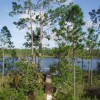 Conservation easements are cost-effective means for government agencies or non-government conservation organizations to protect land. Instead of purchasing land outright, these agreements allow organizations to purchase the development rights of a property. This protects the land and saving money. Landowners who choose this option prevent future residential and commercial development of their land, and reduce the amount of inheritance tax liability. Landowners are encouraged to enter such agreements carefully because they require several rights to be conveyed to the easement grantee and the duration of these agreements is typically perpetual. This 5-page fact sheet describes conservation easements, what is involved in establishing one, tax implications, participating government and non-government organizations, and important considerations for landowners. Written by Chris Demers and Douglas R. Carter, and published by the UF Department of School of Forest Resources and Conservation, March 2014.
Conservation easements are cost-effective means for government agencies or non-government conservation organizations to protect land. Instead of purchasing land outright, these agreements allow organizations to purchase the development rights of a property. This protects the land and saving money. Landowners who choose this option prevent future residential and commercial development of their land, and reduce the amount of inheritance tax liability. Landowners are encouraged to enter such agreements carefully because they require several rights to be conveyed to the easement grantee and the duration of these agreements is typically perpetual. This 5-page fact sheet describes conservation easements, what is involved in establishing one, tax implications, participating government and non-government organizations, and important considerations for landowners. Written by Chris Demers and Douglas R. Carter, and published by the UF Department of School of Forest Resources and Conservation, March 2014.
http://edis.ifas.ufl.edu/fr149
Tag: Douglas R. Carter
Conservation Easements: Options for Preserving Current Land Uses (SSFOR21/FR149)
Many landowners have a strong connection to their land and want to ensure its protection for many generations. Conservation easements can prevent future residential and commercial development of one’s land, and reduce inheritance tax liability for one’s heirs. This 6-page fact sheet will describe conservation easements, what is involved in establishing one, some of the tax implications of such agreements, the government and non-government organizations that commonly participate in conservation easements, and important considerations for landowners before entering into such an agreement. Written by Chris Demers and Douglas R. Carter, and published by the UF School of Forest Resources and Conservation, March 2011.
http://edis.ifas.ufl.edu/fr149